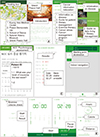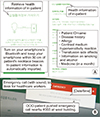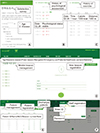Abstract
Objectives
This paper describes an experience of implementing seamless service trials online and offline by adopting Internet of Things (IoT) technology based on near-field communication (NFC) tags and Bluetooth low-energy (BLE) beacons. The services were provided for both patients and health professionals.
Methods
The pilot services were implemented to enhance healthcare service quality, improve patient safety, and provide an effective business process to health professionals in a tertiary hospital in Seoul, Korea. The services to enhance healthcare service quality include healing tours, cancer information/education, psychological assessments, indoor navigation, and exercise volume checking. The services to improve patient safety are monitoring of high-risk inpatients and delivery of real-time health information in emergency situations. In addition, the services to provide an effective business process to health professionals include surveys and web services for patient management.
Results
Considering the sustainability of the pilot services, we decided to pause navigation and patient monitoring services until the interference problem could be completely resolved because beacon signal interference significantly influences the quality of services. On the other hand, we had to continue to provide new wearable beacons to high-risk patients because of hygiene issues, so the cost increased over time and was much higher than expected.
Conclusions
To make the smart connected hospital services sustainable, technical feasibility (e.g., beacon signal interference), economic feasibility (e.g., continuous provision of new necklace beacons), and organizational commitment and support (e.g., renewal of new alternative medical devices and infrastructure) are required.
The ‘smart connected world’ is an environment in which various objects can store, process, and exchange information seamlessly using Internet of Things (IoT) technologies. IoT technologies have been applied to various fields, such as manufacturing, energy, the automobile industry, and healthcare, and IoT-based products and services are being produced and used in the market. In particular, the IoT is predicted to cause many changes in the manufacturing and healthcare industries [12]. In addition, the mobile-based healthcare service market is expected to rapidly expand with the growing prevalence of smartphones and the improvement of the mobile communication network environment [3], such LTE and 5G. IoT-based products consist of physical, smart, and connectivity elements.
IoT-based products and services provide functions such monitoring, remote-control, optimization, and autonomy. In particular, in the healthcare industry, IoT-based products and services create value by providing monitoring functions for high-risk patients and those with chronic illnesses [45]. However, the healthcare industry still lacks appropriate IT support. There are still problems regarding misidentification of patients or drugs or improper management of medical equipment. Moreover, problem regarding data inaccuracy and inconsistency occur with unintegrated data management systems [6].
Based on active research of IoT technology-based service models [7], this study aims to provide new value to patients by implementing services that monitor high-risk patients, inpatients, and outpatients particularly based on RFID tag technology (near-field communication [NFC]) and Bluetooth low-energy (BLE) beacon technology. By providing new information that could not be acquired in the past to health professionals, they are expected to enhance decision-making capability. In particular, this paper describes the experience of providing services through web and mobile application to outpatients and inpatients to provide effective work processes to health professionals.
As a result of this pilot project, patients could acquire rich health information offline, and the service improved their experience with new types of services. In particular, the healthcare services were designed to be continuously provided to patients even after leaving the hospital. Thus, the hospital could have a continuous relationship with the patients, and we expected that patients would have higher satisfaction with these services.
Services were developed for the purpose of improving healthcare, enhancing patient safety, and improving the work processes of health professionals. Herein, we describe the services, user interface (UI), and service effects.
The functions for healthcare service quality include healing tours, cancer information/education, psychological assessments, indoor navigation, and exercise volume checks. The functions are summarized in Table 1, and UIs of smartphones are presented in Figure 1.
(1) Healing tours regularly provide psychotherapy for cancer patients about twice a year at six healing locations. However, the health professionals had to pay a lot of time and cost because they had to accompany their patients. Therefore, we designed and implemented a self-service function that allows patients to check the location information of each healing location through a smartphone application and to read the healing program information. In addition, it provides additional functions that can be shared through social media (e.g., KakaoTalk, Facebook) so that these programs can be promoted. Patients can use the services whenever they want, and the health professionals could focus on other high-risk patients. Health professionals can acquire information on which healing locations are popular based on how often patients touch the tag and receive the record of a beacon signal. This information could be utilized to improve services in the future.
(2) ‘Cancer information/education’ provides appropriate contents based on information regarding the location at which the patient is waiting in the hospital. For example, patients in the waiting room of dermatology may have skin diseases, so the service provides useful content, such as tips to prevent skin diseases. It could be more cost effective than providing paper-based information and is even more efficient in terms of storing and distributing information in real time.
(3) ‘Psychological assessment’ is a self-service that allows cancer patients to check their psychological state anytime, anywhere. This information could be also sent to health professionals so that they can recommend the appropriate education program to patients according to their psychological state.
(4) The hospital where the pilot study was implemented provides both western medicine and oriental medicine services. It is not easy for patients to find a clinic or treatment room. ‘Indoor navigation’ is a service that enables outpatients to easily find their destination by inputting the starting point and destination. Therefore, health professionals could be less interrupted by outpatients' requests for directions on how to get to specific locations.
(5) ‘Exercise volume check’ was developed for health professionals to prescribe exercise to patients and to check whether the exercise is performed based on digitally recorded information (beacon signal receiving record) rather than asking patient whether or not they have exercised. A patient wears a necklace beacon, and the beacon signal is caught by the beacon scanner. It is attached to the exercise course so that the health professionals and the patient can check the exercise time, distance, and calorie consumption. Therefore, health professional can monitor the effect of movement therapy.
The functions for patient safety consist of monitoring high-risk inpatients and delivering real-time health information of inpatients in emergency situations. The function descriptions and UIs are presented in Table 2 and Figure 2, respectively.
(1) A high-risk inpatient wear a necklace beacon, and when an emergency button is pressed, the patient's information and location information is delivered to the health professionals with sound. Therefore, it is possible to detect patient emergency situations early and respond quickly.
(2) The delivery of real-time health information of inpatients in emergency situations is a service that can check the health information needed to cope with the emergency situation right on the spot. Previously, it was necessary to go to the health professionals' workstations to check patient information and return to the patient, but this service allows health professionals to use the smartphone application to catch the signal from the patient's necklace beacon. The patient's information can be sent immediately to their smartphones, and they can quickly copy with emergency situations.
The functions to assist the work process of health professionals include surveys and web services for patient management. Table 3 and Figure 3 present the functions and UIs, respectively.
(1) The pilot study hospital provides 14 education programs for cancer patients. After completion of each program, a survey is conducted through the smartphone application instead of paper-based survey. This could improve work efficiency and ensures the accuracy of information by eliminating the process by which health professionals digitize the results of paper-based surveys.
(2) ‘Web service for patient management’ provides service results, such as exercise volume checks, psychological assessments, the popularity of specific healing locations, and satisfaction with educational programs. To provide beacon and tag-based services, information such as the ID of each tag and beacon and the location attached to them should be uploaded to the web (beacon and tag management service). The information should be uploaded to the web to see which patient is wearing a specific beacon (patient management service). Finally, health professionals’ information is entered into the system to grant them access to the web service (health professional management service).
With the emergence of IoT sensor technologies, widely adopted smartphones and wearable devices now enable patients and health professionals to communicate information conveniently and effectively [8]. We developed a pilot service to mitigate the problems that hospitals are struggling with by applying IoT, thereby to enhance customer satisfaction and improve hospital competitiveness. This is expected to lead to an increase in customer confidence and to have a positive impact on sales growth. The pilot study hospital is expected to show increased productivity due to effective improvement of the existing work process.
However, the pilot services are no longer available. We can think of many reasons why the innovative services could not be sustained. First, the technologies are not mature enough for the hospital to invest their efforts to sustain the new services. NFC tags are not accessible through most iPhones yet, and its alternative BLE beacons suffer from the necessity of battery change. In the near future, every iPhone will be able to read NFC tags and solar-powered BLE beacons will be developed. Time will solve these technical problems. Second, the pilot project was started as a government-supported R&D initiative. Therefore, economic feasibility was not seriously considered. The hospital did not invest its private budget for ongoing services. The aim of the pilot project was to investigate the technical and economic feasibility of the services. Therefore, the project's goal was accomplished. If the technical and economic feasibility were proved positive, the hospital would commit to implementing the services at an organizational level. Therefore, the decision making of the hospital can be considered rational.
The emergence of new technologies and infrastructures has led to the emergence of new business models and the decline of existing business models [4910]. For example, blood glucose self-monitoring product and services, such as ‘Dexcom CGM, iBG Star’ have already been launched and can replace healthcare services of hospitals for this purpose [1112]. Hospitals need to develop differentiated services; therefore, business model innovation of hospitals is necessary. For such business model innovation, we expect that the pilot project described in this paper, can provide useful insights to stakeholders.
Figures and Tables
 | Figure 1Service user interfaces for healthcare service quality: (A) healing tour, (B) cancer information/education, (C) psychological assessment, (D) indoor navigation, and (E) exercise volume check. |
 | Figure 2Service user interfaces for patient safety: (A) delivery of real-time health information of in-patients in emergency situations and (B) monitoring of high-risk in-patients. |
Acknowledgments
This work was supported by the Ministry of Education of the Republic of Korea and the National Research Foundation of Korea (No. NRF-2017S1A5B8059804).
References
1. Evans D. Internet of Things: the evolution of the internet changing everything [Internet]. San Jose (CA): Cisco IBSG;2011. cited at 2018 Oct 1. Available from: https://www.cisco.com/c/dam/global/ko_kr/assets/executives/pdf/internet-of-things-iot-ibsg-0411final.pdf.
2. International Telecommunications Union. The Internet of Things [Internet]. Geneva, Switzerland: International Telecommunications Union;2005. cited at 2018 Oct 1. Available from: https://www.itu.int/net/wsis/tunis/newsroom/stats/The-Internet-of-Things-2005.pdf.
3. Deloitte Insights. The Internet of Things: a technical primer [Internet]. New York (NY): Deloitte Insights;2018. cited at 2018 Oct 1. Available from: https://www2.deloitte.com/content/dam/insights/us/articles/4420_IoT-primer/DI_IoT-Primer.pdf.
4. Porter ME, Heppelmann JE. How smart, connected products are transforming competition. Harv Bus Rev. 2014; 92(11):64–88.
5. Porter ME, Heppelmann JE. How smart, connected products are transforming companies. Harv Bus Rev. 2015; 93(10):96–114.
6. Yao W, Chu CH, Li Z. The adoption and implementation of RFID technologies in healthcare: a literature review. J Med Syst. 2012; 36(6):3507–3525.

7. Park A, Chang H, Lee KJ. Action research on development and application of Internet of Things services in hospital. Healthc Inform Res. 2017; 23(1):25–34.

8. Kim J, Kam HJ, Park YR, Yoo S, Oh JS, Kim YH, et al. Enchanted life space: adding value to smart health by integrating human desires. Healthc Inform Res. 2018; 24(1):3–11.

9. Lee KJ, Jun JH. Internet of Things and business opportunity [Internet]. Seoul, Korea: Dong-A Business Review;2014. cited at 2018 Sep 24. Available from: http://dbr.donga.com/article/view/1101/article_no/6593.
10. Chesbrough H, Rosenbloom RS. The role of the business model in capturing value from innovation: evidence from Xerox Corporation's technology spin-off companies. Ind Corp Change. 2002; 11(3):529–555.

11. Dexcom G5 mobile CGM system [Internet]. San Diego (CA): Dexcom Inc.;c2018. cited at 2018 Sep 13. Available from: https://www.dexcom.com/g5-mobile-cgm.
12. BGStar [Internet]. Paris, France: Sanofi;c2018. cited at 2018 Sep 13. Available from: https://www.mystarsanofi.com/products/bgstar.




 PDF
PDF ePub
ePub Citation
Citation Print
Print







 XML Download
XML Download